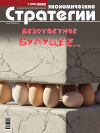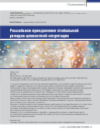Russian Overcoming of Global Value-Based Segregation
DOI: 10.33917/es-1.187.2023.39-45
The article provides a modern answer to Adam Smith’s classic question on how exactly the vital assets of peoples are created in the states. It is shown that vital assets in the states are originally created through extraction (for a human), production (for a human) and imputation (into a human), which are three qualitatively different main types of vital creativity.
This results in identification of three main patterns of life: extractive, productive and imputative. It is argued that with any basic form of life creativity, creation of a changing variety of life assets in the states is carried out mainly due to inclusion of a larger mental component in all creative chains.
However, creation of a larger mental capacity can occur only through the concomitant and inevitable expenditure of both the same energy and the same information. Inevitable need for this mentioned expenditure (consumption) is the creative “damnation” of mankind.
Strategies for Russia’s exit from modern interstate exploitation are described. It is а proved that strategically and epochally the best way for Russia to get out of this system of exploitation is to recreate a sovereign, full-fledged three-pattern vitality, where combination of the main life patterns satisfies the life code that is historically inherent in Russia.
It is shown that due to the presence of the mentioned “damnation”, modern Russia has got an energy “lever” that is sufficient (if used correctly) to create its own anti-segregation macro-regional cooperants without pattern-based segregation.
References:
1. Zakharov V.K. Nomologiya. Mir i Rossiya. Kto vinovat? i Chto delat’? [Nomology. World and Russia. Who is guilty? and What to do?]. Moscow, Rodina, 2022, 668 p.
2. Anilionis G.P., Zotova N.A. Global’nyi mir: edinyi i razdelennyi. Evolyutsiya teorii globalizatsii [Global World: United and Divided. Evolution of Globalization Theories]. Moscow, Mezhdunarodnye otnosheniya, 2005, 676 p.
3. Bolduin R. Velikaya konvergentsiya. Informatsionnye tekhnologii i novaya globalizatsiya [Great Convergence. Information Technology and New Globalization]. Moscow, Delo, 2018, 415 p.
4. Dobren’kov V.I. Globalizatsiya. Sushchnost’, proyavleniya i sotsial’nye posledstviya [Globalization. Essence, Manifestations and Social Consequences]. Moscow, Akademicheskii proekt, 2018. 636 s.
5. Porter M.E. Mezhdunarodnaya konkurentsiya. Konkurentnye preimushchestva stran [International Competition. Competitive Advantages of Countries]. Moscow, Al’pina Pablisher, 2016, 947 p.
6. Men’shikov S.M. Anatomiya rossiiskogo kapitalizma [Anatomy of Russian Capitalism]. Moscow, Mezhdunarodnye otnosheniya, 2004, 432 p.
7. Ryazanov V.T. (Ne)Real’nyi kapitalizm. Politekonomiya krizisa i ego posledstvii dlya mirovogo khozyaistva i Rossii [(Un) Real Capitalism. Political Economy of the Crisis and of Its Consequences for the World Economy and Russia]. Moscow, Ekonomika, 2016, 695 p.
8. Fedorenko N.P. Rossiya na rubezhe vekov [Russia at the Turn of the Century]. Moscow, Ekonomika, 2003, 727 p.



